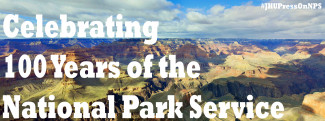
Johns Hopkins UniversityEst. 1876
America’s First Research University
Stephen T. Mather and His Legacy with the National Park Service

The National Park Service (NPS) celebrates its centennial anniversary in the month of August! NPS has served as a valuable resource for many of our authors, both professionally and recreationally. To commemorate the occasion, our authors have taken to the blog to pay homage to “America’s best idea”! Check back with us throughout the month of August for more #JHUPressOnNPS! (Series photo credit: Wikimedia)

We toil our way up the Golden Staircase in Kings Canyon National Park, pilgrims on an odyssey southward via the John Muir Trail. Our packs are heavy, the afternoon is hot, and the staircase steps carved from living granite are of irregular spacing and height. We walk with care, placing our booted feet with precision; a stumble might lead to injury, and an injury here in this remote place would, as they say, have consequences.
We top out into a narrow valley surrounded by soaring peaks of bare granite. The view is stark but grand. Upper Palisade Lake provides water to drink (after filtering) and a chilling soak for hot, tired feet. Yet after a rest, there is a still a long climb ahead, up more switchbacks paved only with piles of tennis-ball-sized rocks. Upward, ever upward, we climb to our destination, Mather Pass, 12,100 feet above the level of the sea.
It’s a familiar name, Mather. In our quest to visit all 59 National Parks, we have encountered it before: Mather Point in Grand Canyon National Park, Mather Gorge of the Potomac River in C&O Canal National Historical Park, the Stephen T. Mather training facility in Harpers Ferry National Historical Park, and bronze plaques in Acadia, Yosemite, and Zion National Parks. So who was Stephen T. Mather, and why is his name so ubiquitous in our national parks?
Stephen T. Mather was a self-made millionaire (responsible for the marketing slogan “20 mule team borax”) who loved to hike and camp in the Sierra Nevada. Distressed at conditions in Yosemite and Sequoia National Parks, he complained to the Secretary of the Interior, who promptly offered him a job to fix those problems. Using his immense energy, charm, and personal fortune, Mather soon persuaded Congress to create a federal agency devoted solely to management of the national parks; thus the National Park Service was established via passage of the Organic Act by Congress on August 25, 2016, a century ago. Mather was appointed the first Director, and in his thirteen-year tenure added new parks (like Zion, Grand Canyon and Rocky Mountain), expanded the boundaries of already established parks (like Yosemite and Yellowstone), professionalized a cadre of superintendents and rangers, brought visitor services like lodging, campgrounds, and roads to the parks, and instituted interpretive programs about nature. His legacy is still felt: national park rangers are perhaps the most dedicated and admired group of federal employees, the parks established under his tenure are among our most treasured, and he laid the foundation for the status of our national parks as “America’s Best Idea”.
Bryan MacKay is a senior lecturer emeritus in the Department of Biological Sciences at the University of Maryland, Baltimore County. He is the author of Hiking, Cycling, and Canoeing in Maryland: A Family Guide and Baltimore Trails: A Guide for Hikers and Mountain Bikers, both published by Johns Hopkins University Press. 

